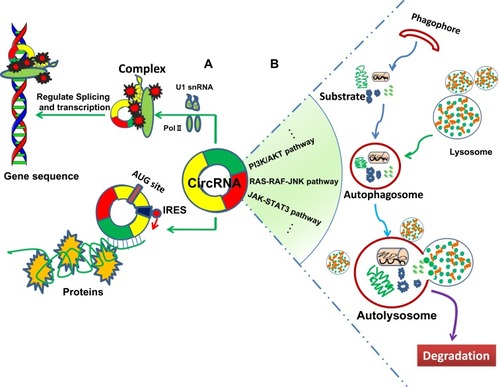Figures & data
Figure 1 circRNAs involve in cancer progression by acting as “miRNA sponge” or protein scaffolding. (A) circRNAs competitively bind to miRNA with the participation of Ago2 protein by acting as “miRNA sponge,” consequently release the target gene of miRNA. (B) circRNAs directly interact with RNA-binding proteins (RBPs), or mediate the interaction between proteins by serving as protein scaffolding to regulate the expression of downstream targets.

Figure 2 circRNAs involve in cancer progression by regulation of gene splicing, transcription, translation and cell autophagy. (A) circRNAs influence the progression of human cancers by regulating gene splicing, transcription and translation via interaction with U1 small nuclear RNA (snRNA), RNA polymerase II (Pol II), and alternative splicing regulator. Moreover, circRNA containing AUG sites and open reading frame (ORF) driven by the internal ribosome entry site (IRES) may translate into the functional protein. (B) circRNAs are associated with the tumor cell autophagy through regulating the autophagy-related signaling pathways.

Table 1 Expression and Functional Characterization of circRNAs in Cancers
Table 2 The Roles in Clinical Relevance and Prognosis of circRNAs in Human Cancers
